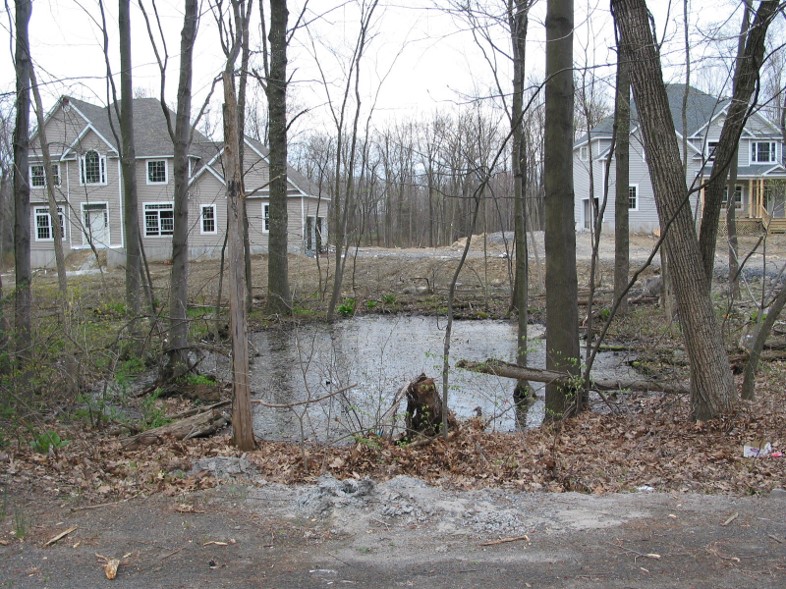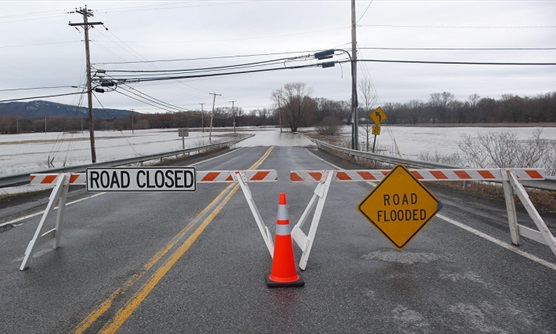Threats to Biodiversity in the Watershed
Numerous issues are facing biodiversity and natural areas conservation in the estuary watershed. The Wildlife and Habitat Conservation Framework (Penhollow et al. 2006) provides an overview of threats and discusses specific strategies to address them. Many of these threats interact, causing intensified impacts. The Conservation Planning section of this website offers conservation and land-use approaches to avoid and minimize these challenges to biodiversity conservation.
Habitat Loss and Fragmentation
The Hudson River estuary watershed is one of the fastest growing regions of New York State. Past land-use trends have raised concern about sprawling development patterns that consume land inefficiently (Pendall 2003). These patterns often cause habitat fragmentation – the division of large, contiguous habitats into smaller, isolated pieces. Connectivity of aquatic habitats can be similarly compromised from dams and culverts that block pathways for fish, turtles, and other stream species. In addition, small-scale losses of vulnerable (and often overlooked) habitats, like woodland pools, have further damaged complex ecosystems and pose challenges to wildlife. Today, planners face new challenges including development of renewable energy projects, which can help to advance climate goals but also impact natural areas if sited inappropriately (Scenic Hudson 2018). Overall, the continuing loss, degradation, and fragmentation of habitat poses a lasting and serious threat to biodiversity.
Uncoordinated Planning
While land protection of large forested mountains and ridges has contributed to biodiversity conservation in the Hudson Valley, 82% of the watershed is in private ownership—where the individual land-use decisions of landowners and more than 250 town, village, and city governments can have significant and lasting impacts on biodiversity. These decisions typically don’t consider the relationship of a particular site to adjacent natural areas, downstream water resources, large landscape features, or the surrounding watershed. Coordination across multiple municipal jurisdictions can be challenging, but it's critical for avoiding patterns of land-use change that cause habitat loss and fragmentation.
Climate Change
New York’s changing climate presents challenges for both human communities and ecological communities. Since 1970, annual average temperatures in the state have increased two degrees Fahrenheit, with winter temperatures up almost five degrees Fahrenheit. Precipitation is more variable and extreme, and heat waves, drought, and flooding are increasing in frequency. In the Hudson estuary, the water level is rising with global sea level. Together, these changing conditions are having widespread impacts on biodiversity.
In an assessment of 119 wildlife species in the state, the NY Natural Heritage Program found 70 (59%) are vulnerable to climate change, with mollusks and amphibians more vulnerable than other taxonomic groups (Schlesinger et al. 2011). Audubon found that 48% of New York’s 280 bird species are vulnerable to climate change across seasons (Audubon 2019). Along the shorelines of the estuary, tidal marshes will need to shift inland to avoid inundation from rising sea levels (Scenic Hudson 2016), and in the watershed, ecological communities and wildlife may need to shift farther north or to higher elevations to adapt to the changing climate (Howard and Schlesinger 2012).
Invasive and Overabundant Species
Invasive species are also a significant threat to New York’s biodiversity, causing degradation of terrestrial and aquatic habitats, altering of species composition in ecological communities, and loss of native fish, wildlife, and plant species. Invasive non-native organisms include plants like water chestnut and giant hogweed; animals like emerald ash borer and Asian carp; and pathogens like oak wilt. Overabundant native species like white tailed deer can also alter ecosystems and affect biodiversity. Local reductions in biodiversity can similarly be caused by native species that flourish in urban and suburban areas, like raccoons that prey on eggs and juveniles of other species, and brown-headed cowbird, a “brood parasite” that lays its eggs in the nests of other species. The presence and proliferation of invasive species often go hand-in-hand with other threats to biodiversity like habitat fragmentation and climate change.
Helpful Links
Hudson River Estuary Wildlife and Habitat Conservation Framework (Penhollow et al. 2006)
Habitat Loss and Fragmentation
Sprawl Without Growth: The Upstate Paradox (R. Pendall 2003)
Aquatic Connectivity and Barrier Removal NYSDEC Website
Clean Energy, Green Communities: A Guide to Siting Renewable Energy in the Hudson Valley (Scenic Hudson 2018)
Climate Change
Fact Sheet on Climate Change in the Hudson Valley
Vulnerability of At-risk Species to Climate Change in New York (Schlesinger et al. 2011)
PATHWAYS: Wildlife Habitat Connectivity in the Changing Climate of the Hudson Valley (Howard and Schlesinger 2012)
Responding to Climate Change in New York State, NYSERDA Technical Report (Rosenzweig et al. 2011)
How Climate Change will Affect New York’s Birds (Audubon 2019)
Protecting the Pathways: A Climate Change Adaptation Framework for Hudson River Estuary Tidal Wetlands (Scenic Hudson 2016)
Invasive and Overabundant Species
Deer Overabundance NYSDEC Website
Nuisance and Invasive Species NYSDEC Website
Partnerships for Regional Invasive Species Management (PRISM) NYSDEC Website


